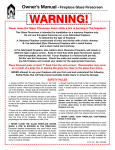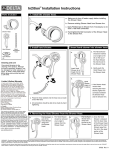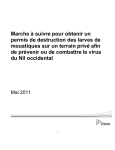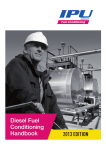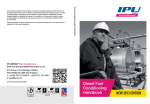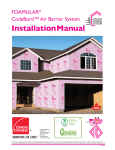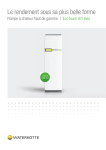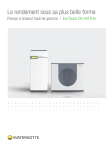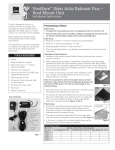Download (EPD): EcoTouch® Unfaced Insulation
Transcript
Environmental Product Declaration EcoTouch® Unfaced Insulation Owens Corning, and its family of companies, are a leading global producer of residential and commercial building materials, glassfiber reinforcements, and engineered materials for composite systems. Founded in 1938, Owens Corning has earned its reputation as a marketleading innovator of glass-fiber technology by consistently providing new solutions that deliver a strong combination of quality and value to its customers across the world. Building Materials products – primarily roofing and insulation – are focused on making new and existing homes and buildings energy efficient, comfortable, and attractive. Owens Corning is committed to balancing economic growth with social progress and sustainable solutions to its building materials and composites customers around the world. This Environmental Product Declaration is a component of our stated goal to provide life cycle information on all core products. www.owenscorning.com. Owens Corning EcoTouch® Insulation with PureFiber® Technology enhances comfort, energy savings and sustainability in new and existing structures. The color PINK is a registered trademark of Owens Corning. ©2012 Owens Corning. All Rights Reserved. EcoTouch® Unfaced Insulation According to ISO 14025 This declaration is an environmental product declaration in accordance with ISO 14025 that describes the environmental characteristics of the aforementioned product. It promotes the development of sustainable products. This is a certified declaration and all relevant environmental information is disclosed. PROGRAM OPERATOR DECLARATION HOLDER DECLARATION NUMBER UL Environment Owens Corning 12CA25418.103.1 ® REFERENCE PCR EcoTouch Unfaced Insulation. Manufactured by Owens Corning in the United States and Canada. PCR Building Envelope Thermal Insulation (ULE 2011) DATE OF ISSUE PERIOD OF VALIDITY October 29, 2012 5 years DECLARED PRODUCT Product definition and information about building physics CONTENTS OF THE DECLARATION Information about basic material and the material’s origin Description of the product’s manufacture Indication of product processing Information about the in-use conditions Life cycle assessment results Testing results and verifications The PCR review was conducted by: This declaration was independently verified in accordance with ISO 14025 by Underwriters Laboratories ☐ INTERNAL X EXTERNAL This life cycle assessment was independently verified in accordance with ISO 14044 and the reference PCR by: UL Environment PCR was approved by Panel 333 Pfingsten Road Northbrook, IL 60062 [email protected] Loretta Tam Thomas P. Gloria EcoTouch® Unfaced Insulation According to ISO 14025 Product Definition and Information Product Description ® ® ™ ® EcoTouch PINK FIBERGLAS Insulation with PureFiber Technology is flexible insulation and is made in R-values from 11 to 38 for United States markets. For the Canadian market, the R-Values are from 12 to 40. The unfaced insulation is manufactured in thicknesses from 31/2” to 12”. The functional unit of the product as defined by the PCR is 1 square meter of insulation material with a thickness that gives an average thermal resistance RSIsi=1 m2K/W and with a building service life of 60 years. The results of this declaration represent an average performance for a number of products and manufacturing plant locations. Manufacturing Locations Owens Corning North American Insulation Manufacturing Locations can be found across the United States and Canada. (a) (b) Delmar Planta Fuera Bush, N.Y. 12067 Fairburn Plant Fairburn GA., 30123 Santa Clara Plant Santa Clara, CA. 95050 Waxahachie Plantb Waxahachie, TX 75165 Edmonton Plant Edmonton, Alberta, Canada T6S1A1 Kansas City Plant Kansas City, KS. 66115 Toronto Plant Scarborough, Ontairo, Canada M1V1Z5 Manufacturing location was not included in LCA for unfaced insulation. The Waxahachie plant was converted in May 2011 and uses the same process and bill of materials as the plants covered in the study. EcoTouch® Unfaced Insulation According to ISO 14025 Application and Uses ® EcoTouch Insulation can be used in a wide range of exterior wall, floor, roofing and ceiling applications for residential ® and commercial installations. EcoTouch Insulation is provided with a wide range of R-values and thicknesses with excellent thermal control. The R30C, and R38C for use in the USA and R28 and R31 as used in Canada, provide ® excellent thermal performance in limited space of cathedral ceilings. EcoTouch Insulation enhances interior noise control by improving Sound Transmission Class (STC) of walls and floor/ceiling assemblies Installation ® EcoTouch Insulation is easy to handle and install. Sized for installation in either wood or metal frame construction, ® Unfaced EcoTouch Insulation is friction fit into place. Trimming and fabrication can be done with a utility knife and can be cut to fit into odd-shaped cavities and small spaces. With less dust than other fiberglass insulation products, ® EcoTouch Insulation has excellent stiffness and recovery characteristics. ® EcoTouch Unfaced Insulation can be friction-fit between studs after the cover material has been installed on one side of the cavity. Use wire or metal straps to hold insulation in place in applications without a cover material, or where the insulation does not fit the depth of the cavity. Cathedral ceiling products are intended to be friction-fit between rafters. Cathedral ceiling insulation when installed per manufacturer’s instructions is designed to provide a minimum of 1” ventilation passageway between the roof deck and insulation. ® For metal studs, EcoTouch Insulation can be friction-fit in place until the interior finish is applied. Insulation should fill the cavity and the wall should eventually be closed on both sides ® EcoTouch Insulation can be applied between furring strips, hat channels, or Z-shaped furring in areas where a finished surface will be installed. Contact furring strip manufacturer for appropriate fastening system. EcoTouch® Unfaced Insulation According to ISO 14025 Material Content ® Cullet Sand Borates Soda Ash Other Oxides Limestone Carbohydrate Polyol Bio-Based Polycarboxlic Acid Cure Accelerator Surfactant Vegetable Oil Silane Pink Colorant Glass Batch Glass Batch Glass Batch Glass Batch Glass Batch Glass Batch Binder Binder Binder Binder Binder Binder Binder Quantity (% by Mass) 25-75% 8-25% 10-30% 0.5-6% 1-2% 0-5% 2-10% 1-5% 0.2-1% 0-0.1% 0-3.5% 0.03-.1% 0.1-0.2% Recycle Material Function Renewable Materials NonRenewable Unfaced EcoTouch Insulation consists of two major components, the fiberglass and the binder system. The fiberglass is made from various inorganic minerals, which are referred to as batch chemicals. The binder system consists of renewable and non-renewable organic chemicals. Origin Transportation Mode Transportation (Miles) North America North America Global North America North America North America North America North America North America North America North America North America North America Rail/Truck Truck Ship/Rail/Truck Rail/Truck Rail/Truck Truck Truck Truck Truck Truck Truck Truck Truck 10-800 10-250 350-6200 350-2000 225-2000 125-200 500-2200 200-2000 250-2300 400-2300 500-2200 250-2700 350-2800 Table 1: Material Content of Unfaced Fiberglass Insulation Manufacturing Process EcoTouch® Unfaced Insulation According to ISO 14025 Environmental Product Declaration Use of Material and Energy Resources Table 1: Total Primary Energy Total Primary Energy Non renewable, fossil Non-renewable, nuclear Renewable, biomass Renewable, wind, solar, geothermal Renewable, water Unit MJ-Eq MJ-Eq MJ-Eq MJ-Eq MJ-Eq Total 8.58 0.67 0.36 0.0022 0.31 Table 2: Total Primary Energy Detail by Source Type Unit Total Renewable Primary Energy Source Fossil Oil MJ-Eq 1.47 Hydropower MJ-Eq 0.31 Natural Gas MJ-Eq 4.33 Wind Power MJ-Eq 0.0022 Coal MJ-Eq 2.78 Solar Power MJ-Eq 5.72E-05 Uranium MJ-Eq 0.67 Biomass MJ-Eq 0.36 Non-Renewable Primary Energy Source Non-Renewable Energy by Source Unit Total Renewable Energy by Source 7.2% 15.9% 46.1% Fossil Oil 30.1% Hydropower Natural Gas Wind Power Coal Solar Power Uranium Biomass 53.6% 46.8% 0.0% 0.3% EcoTouch® Unfaced Insulation According to ISO 14025 Use of Material and Energy Resources 0.7% 5.0% 18.3% As shown by the pie chart, the fiberglass manufacturing process is energy intensive but since insulation is a passive device, the use phase consumes zero primary energy, and in fact actually saves energy in a building. Batch Materials Binder Materials Packaging Materials 9.6% R.M. Transport Fiberglass Manufacturing 3.7% 1.8% 61.5% F.G. Distribution Use End of Life Life Cycle Assessment-Product System and Modeling of Life Cycle Functional Unit The functional unit of the product as defined by the PCR is 1 square meter of insulation material with a thickness that gives an average thermal resistance RSI=1 m2K/W and with a building service life of 60 years. Life Cycle Stages Assessed ® The EcoTouch Insulation study for the manufacturing of unfaced fiberglass batts and rolls was a cradle-to grave analysis, which included the following: • • • • • • Raw material production including extraction of primary raw materials, raw material manufacturing, raw materials for packaging, recycle cullet collection and processing, All raw material, packaging material and recycle cullet material to manufacturing locations. Fiberglass manufacturing Packaging of Finished Goods. Finished Good Transportation to from Manufacturing Facilities to Distribution centers, and Retailers. End-of-Life; Decommissioned material transportation to Waste Landfill and Landfill. EcoTouch® Unfaced Insulation According to ISO 14025 System Boundaries Assumptions Assumptions are critical in conducting a life cycle assessment. For this cradle-to-grave life cycle, a major assumption is for the installation, use and maintenance phase. Installing unfaced fiberglass batt is performed by hand. They are unrolled or unwrapped, cut to appropriate size and friction fit into a wall cavity between the studs. This activity requires no other external utility source such as electrically, or other fuel. Once the batt is installed, the interior wall is finished and the batt is completely encased and protected. During the sixty-year life of the home as defined in the study, the batt would require no other utility source to operate (passive device). Finally, unless some type of serious damage occurred to the wall of a home, the maintenance on a fiberglass batt would not be required. In conclusion, for this study, a use/maintenance phase had zero impact value for the life cycle. The major benefit of insulation is that it saves energy over the life of the home. See section on “Additional Environmental Benefits” for energy savings for homes due to insulation of walls, ceilings, floors and foundations. All data reported is a North American weighted averaged for five of the six North American, Owens Corning plants that produced 71% unfaced residential batts/rolls for the year 2011. Cut-Off Criteria The cut-off criteria for the study are as follows: • • • Mass – If a flow is less than 2% of the cumulative mass of the model, it may be excluded, providing it environmental relevance is not a concern. Energy – If a flow is less than 1% of the cumulative energy of the model, it may be excluded, providing its environmental relevance is not a concern, Environmental Relevance – Materials of omission that may have a relevant contribution will be justified if applicable, by a sensitivity analysis. EcoTouch® Unfaced Insulation • According to ISO 14025 The sum of the excluded material flows must not exceed 5% of mass, energy, or environmental relevance. Transportation Each participating plant supplied the transportation distances for the shipment of all raw materials to their respective facility by the data input questionnaires as used in the study. Owens Corning’s Corporate Transportation Analyst provided the finished good shipments to distributors, retail stores and other customers. Period under Consideration All Owens Corning primary data for the facilities used in the study were from the fiscal year of 2011 Secondary (Background) Data The LCA modeling was created using SimaPro 7.3.2 software for life cycle engineering as developed by PRé Consultants. Secondary data was obtained using the SimaPro database for the raw materials and processes. Data Quality Data quality factors of temporal, geographical, and technology are very important in analyzing the primary information for the study. The five Owens Corning facilities chosen for this study represents the current technology in use geographically cover the United States and Canada, and the data is from the year 2011. The secondary data used from the SimaPro database was the most appropriate and current data available. When production data was not available for a specific material in use, available LCI data on similar materials were analyzed to determine the best surrogate. Allocation Allocation where applicable was carried out by mass, except in transportation where the product is volume limited and not mass limited. Sensitivity analysis should be initiated if a deviation of 20% is foreseen. Since fiberglass products are volume limited for finished goods-transportation, a sensitivity analysis was performed for this study. The finished goods transportation (ton-miles) was changed by +/- 25% for the sensitivity analysis. All of the environmental impact categories changed by less than 1% except for the impact category of smog potential. With a 25% increase in finished good transportation ton-miles, there is a 2% increase in the smog potential value. Use Stage As stated in the Assumptions’ Section above, for this study, the environmental impacts are negligible for the study. End-of-Life For end of life, it was assumed that all materials removed from the decommissioning of a building were taken to a local construction waste landfill, using 100 miles as the average distance to landfill. At this time, there are no formal end-oflife recycling programs for fiberglass insulation. There are some documented cases where removed fiberglass was reused in Habitat for Humanity (HFH) projects and re-sold in HFH stores. EcoTouch® Unfaced Insulation According to ISO 14025 Life Cycle Assessment-Product The LCA Results are documented separately for the following stages • • • • • • • Batch Materials: mining and manufacturing of batch minerals as used in glass batch Binder materials: extraction and manufacturing of chemicals as used in binder process. Cradle to gate manufacturing of packaging materials. Raw Material Transportation: Transport distances for batch, binder, and packaging materials to each respective Owens Corning facility Plant Operations: energy and environmental flows associated with the conversion of batch and binder materials and the packaging operation of finished goods for the production of fiberglass batts and rolls. F.G. Distribution: Transportation (Ton-Miles) for shipment of finished goods from Owens Corning facilities to the distribution, retail centers and other customers. End-of-Life: the transportation of decommissioned fiberglass materials and landfill burden Impact category Global warming Acidification Eutrophication Smog Ozone depletion Respiratory effects Waste to Landfill Metered Water Energy Table3: Life cycle Impact Category Values for the Functional Unit of One Square Meter, RSI=1 Raw Batch Binder Packaging Plant Unit Total Material Materials Materials Materials Operations Transport kg CO2 eq 6.18E-01 1.13E-01 3.54E-02 1.08E-02 1.41E-02 4.03E-01 mol H+ eq 2.37E-01 2.46E-02 1.11E-02 4.38E-03 6.04E-03 1.77E-01 kg N eq 3.82E-04 6.50E-05 2.53E-04 3.90E-06 5.90E-06 4.11E-05 kg O3 eq 3.81E-02 5.96E-03 1.90E-03 1.05E-03 2.95E-03 1.95E-02 kg CFC-11 eq 1.70E-08 1.25E-08 4.18E-09 1.06E-10 7.52E-11 1.36E-10 kg PM2.5 eq 1.46E-02 1.55E-03 4.97E-05 2.45E-05 3.96E-05 1.28E-02 kg 3.98E-01 1.90E-02 3.34E-03 2.23E-04 5.74E-06 1.19E-02 kg 4.76E+00 1.86E+00 1.11E+00 6.91E-01 4.67E-03 1.09E+00 MJ-Eq 9.92E+00 1.81E+00 9.56E-01 3.65E-01 1.76E-01 6.10E+00 F.G. Distribution End-ofLife 3.60E-02 1.20E-02 1.14E-05 5.86E-03 1.57E-12 9.50E-05 0.00E+00 0.00E+00 4.45E-01 5.42E-03 1.80E-03 1.72E-06 8.83E-04 2.37E-13 1.43E-05 3.63E-01 0.00E+00 6.71E-02 How to Calculate Environmental Impact Values for “R” Values other than the Functional Unit. The functional unit for the study is in metric units of R=1, which is equivalent to R=5.68 in U.S Customary Units, which is the value one would find stated on the label of an insulation package as sold in North America. In order to determine the burden for the desired R-value of product sold, the scaling factor for the appropriate R-value as listed in the chart below should used to multiply the impact category value as listed for the functional unit, in Table 3 above. Scaling Factors for Determining Impact Category Values for Commercial R-Values in North America Product (United States) Customary RValue Factor to Multiply Impact per m2 of RSI1 (dimensionless) R-11 R-13 R-15 R-19 R-21 R-30 R-30C R-38 R-38C 2.07 3.07 4.72 3.43 4.96 5.78 6.55 7.03 9.17 Product (Canada only) Customary R-Value R-12 R-14 R-20 R-22 R-24 R-28 R-31 R-40 Factor to Multiply Impact per m2 of RSI1 (dimensionless) 2.45 3.88 3.72 6.10 8.58 5.50 5.99 8.71 EcoTouch® Unfaced Insulation According to ISO 14025 Example: Environmental Burden for R13 Fiberglass Insulation Based on Functional Unit RSI=1 Results In the table below, the results of the study’s functional unit are multiplied by 3.07 to obtain the impact category values for fiberglass insulation rated at R=13. Impact category Global warming Acidification Eutrophication Smog Ozone depletion Respiratory effects Waste to Landfill Metered Water Energy Unit kg CO2 eq mol H+ eq kg N eq kg O3 eq kg CFC-11 eq kg PM2.5 eq kg kg MJ-Eq Functional Unit R=1 (metric) 6.18E-01 2.37E-01 3.82E-04 3.81E-02 1.70E-08 1.46E-02 3.98E-01 4.76E+00 9.92E+00 Values for R=13 Customary Values 1.52E+01 5.82E+00 9.39E-03 9.36E-01 4.16E-07 3.58E-01 9.77E+00 1.17E+02 2.44E+02 Non-hazardous Waste and Water Consumption Table 4 Non-hazardous Waste and Water Usage per Functional Unit of Material – 1 Sq. Meter Raw Materials Fiberglass End-of-Life Production Production Non-Hazardous Waste (kg/Square Meter) Water Consumption (Gal./Square Meter) 0.0225 0.965 0.0119 1.61 0.363 0 Optional Environmental Information Indoor Environmental • ® EcoTouch Insulation has achieved GREENGUARD Children & Schools™ Certification and is verified to be formaldehyde free. Other Environmental • • • • • Product Recycle content for all North American Facilities as certified by SCS Scientific Certification System is 65% minimum overall and 41% from post consumer. Product Recycle content for Canadian only Facilities as certified by SCS Scientific Certification System is 73% minimum overall and 64% from post consumer. UL Environment EcoLogoCM CCD-016 has listed product as a sustainable certified product. ® Unfaced EcoTouch Insulation has been certified under the USDA Bio-preferred label program with a Biocontent label of 98%. Product qualifies to use the Seal & Insulate with ENERGY STAR program label. Building Use Stage Benefits Insulation is a passive device that requires no extra utilities to operate over its useful life. Insulation of a building is responsible for reducing the energy burden associated with heating and cooling of a building. The example below provides the net energy savings (energy saved minus life cycle energy of fiberglass). EcoTouch® Unfaced Insulation According to ISO 14025 Examples Basis: • A two-story 2400 square foot home located in Chicago, Illinois and insulated with batt & roll insulation to meet the 2006 International Energy conservation Code. The methodology used for the energy analysis is ASHRAE Standard 90.2 • A two-story 2400 square foot home located in Phoenix, Arizona Illinois and insulated with batt & roll insulation to meet the 2006 International Energy conservation Code. The methodology used for the energy analysis is ASHRAE Standard 90.2 Table 5: Energy Saved in Homes for First Year and 60 Year Life Home Location Total Life Cycle MJ for Insulation Products used in Home Total MJ Energy Saved for an Insulated Home vs. Non-Insulated Home Net MJ Saved = Total MJ saved minus Total LC MJ Chicago, Illinois Phoenix, Arizona 18,128 16,475 260,693 145,204 242,565 128,729 Payback Time (Days) for Energy Saved 25.4 41.4 MJ Saved over the 60 Year Use Phase of building 1.56E+07 8.70E+06 The energy saved for a properly insulated home over a non-insulated home has a 25.4-day payback for a home in Chicago and a 41.4-day payback for a home in Arizona for the life cycle energy burden associated with the ® manufacturing of EcoTouch Insulation Based on the USEPA Greenhouse Gas Equivalent Calculator, the 60-year energy savings for Chicago (i.e. the energy savings due to the fiberglass insulation) is equivalent to the annual savings of greenhouse gases from 10 automobiles for each of the 60 years. For Arizona, the energy saving due to the fiberglass insulation is equivalent to the annual savings of greenhouse gases from 5 automobiles for each of the 60 years. For building energy savings in other areas of North America, please call 1-800-GET-PINK ® References • • • • • • • • Product Category Rules for Preparing an Environmental Product Declaration (EPD) for Product Groups: Building Envelope Thermal Insulation, Version 1.0, dated September 23, 2011 EN ISO 14025:2006, Environmental labels and declarations – Type III – environmental declarations – Principles and procedures. EN ISO 14040, ISO 14040-2006, Environmental management – Life cycle assessment – Principles and framework. EN ISO, ISO 14044-2006, Environmental management – life cycle assessment – Requirements and Guidelines. ASTM Standard Specification C665-12, Standard Specification for Mineral-Fiber Blanket Thermal Insulation for Light Frame Construction and Manufactured Housing ASTM Standard Specification C518-10, Standard Test Method for Steady-State Thermal Transmission properties of means of Heat Flow Meter Apparatus. ASHRAE Standard 90-2-2007, Energy-Efficient Design Low-Rise Residential Buildings IECC-2006, International Energy Conservation Code. Pub. No. 10018097-B. THE PINK PANTHER™ & ©1964–2013 Metro-Goldwyn-Mayer Studios Inc. All Rights Reserved. The color PINK is a registered trademark of Owens Corning. © 2013 Owens Corning. All Rights Reserved.
















